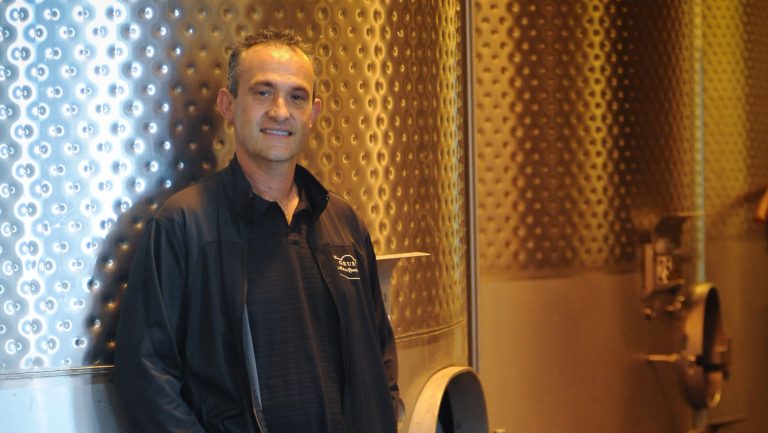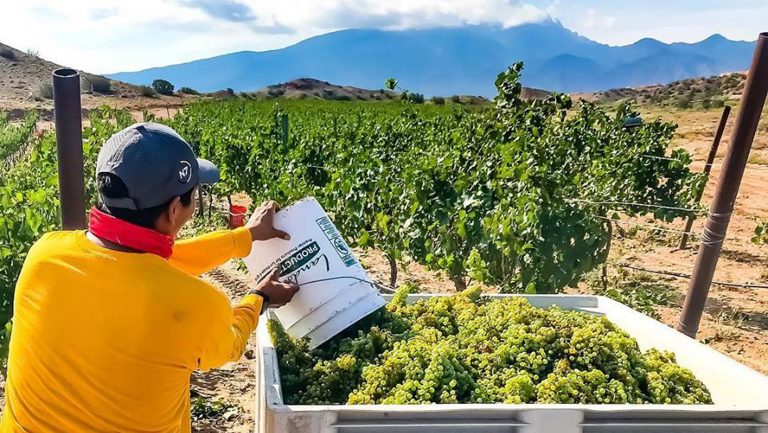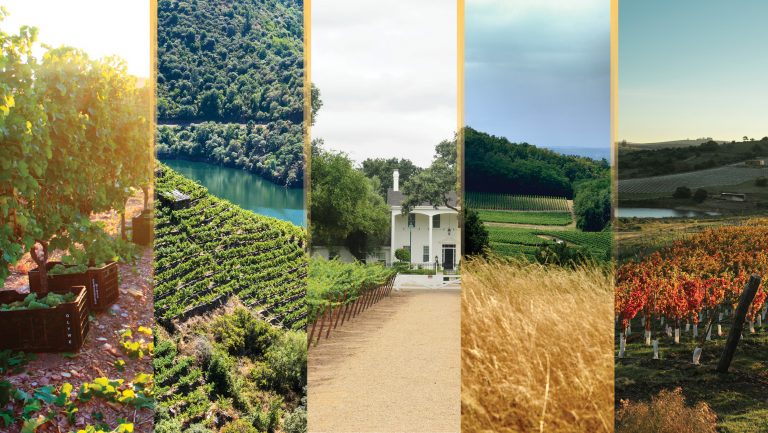Turning out 275,000 cases of wine annually can be a challenge in New Mexico, where the iconic sparkling wine producer Gruet is located. The winery’s méthode Champenoise wines—priced attractively—are winners by the glass at on-premise venues and attract house-label contracts from clients like Total Wine & More, Whole Foods Market, BevMo!, and the ALDI supermarket chain, necessitating nonstop bottling throughout the year to keep up with the pace of sales.
Gruet’s original estate vineyard in central New Mexico and its other contracted fruit source, Luna Rossa, near Deming, don’t supply enough New Mexican Chardonnay, Pinot Noir, and Pinot Meunier to meet demand, and the Gruet vineyard is expensive to irrigate. As a result, the head winemaker, Laurent Gruet, and his nephew, assistant winemaker Sofian Himeur, are forced to bring in fruit from California and Washington. Come harvest time, says Himeur, “we load up refrigerated trucks and haul ass.”
Why not simply grow more grapes in New Mexico? As long ago as 1629, Spanish Franciscan monks planted wine grapes in the region. Labor is inexpensive there today, and the conditions are ideal for sparkling-wine grapes: Chilly nights, calcium-rich sedimentary subsoil, and dry air make for high-acid, mineral-inflected fruit that isn’t prone to rot or disease.

Don’t miss the latest drinks industry news and insights. Sign up for our award-winning newsletters and get insider intel, resources, and trends delivered to your inbox every week.
The Water Problem
Because the New Mexican climate is arid and the topsoils are sandy, any new vineyard plantings would require irrigation. And that’s a problem in a state that’s rationing water after years of drought conditions, and where laws of prior appropriation designate primary water rights to aboriginal American tribes and secondary rights to the descendents of Spanish land-grant recipients.
Added to the complexity of New Mexico’s water situation is that much of the agricultural surface water in the northern part of the state comes through acequias, or irrigation canals, that date back to the days of Spanish colonization—although indigenous Americans used similar systems—and are controlled by local water commissioners, or mayordomos. A conversation about water in New Mexico is never brief.

With such challenges, the idea of planting more vines in its home state didn’t appear to be a feasible option for Gruet. But in 2013, Joseph Bronk, the director of agricultural enterprises for Tamay tribe at the Pueblo of Santa Ana, approached Laurent Gruet and his sister, Nathalie Gruet, the president of Gruet (and Himeur’s mother). Bronk was looking to diversify the pueblo’s agricultural initiatives, and he made a compelling case to the French winemaking family: “We’ve got water rights,” he said. “And a good well.”
The Potential for a New Partnership
While a few indigenous American–owned winemaking ventures—such as the Canadian Nk’Mip Cellars, Kitá Wines in California’s Santa Ynez Valley, and Séka Hills in the Capay Valley, northeast of Napa Valley—have started up in recent years, a grape-growing contract between an indigenous tribe and a winery is a novel concept. Because viticulture is generally characterized by long-term partnerships, a conservative use of drip irrigation, the tendency toward sustainability, and a relatively high net revenue per acre, it could be an appealing option for tribal reservations looking to make the most of their land holdings.
In addition, indigenous tribes are uniquely poised to take on viticulture because they own their land outright and have access to startup funding. Thanks to grants from the Administration for Native Americans and the Southern Pueblos Agency of the Bureau of Indian Affairs, Bronk and the Santa Ana Pueblo were able to pay for initial infrastructure expenditures. With fixed costs covered, a long-term, perennial crop like grapevines looked like a wise investment.
The 73,000-acre Santa Ana Pueblo hugs both sides of the Rio Grande and has found financial success with an alfalfa farm, a native plant nursery, and a line of organic blue corn products. And while the well-drained, sandy loam soil might not be hospitable to many annual crops, it’s ideal for deep-rooted Vitis vinifera.
A Vineyard on the Pueblo
So in 2014 the Santa Ana Pueblo planted a 30-acre vineyard and called it Tamaya, which is the tribe’s traditional, pre-Hispanic name. Gruet and Himeur signed on as viticultural consultants and contracted to purchase the fruit. According to Bronk, the project has created three full-time jobs.
One stumbling block, Bronk concedes, is that “Laurent wants hand-harvested grapes.” If the pueblo could machine harvest, Bronk says, “I’d plant 150 more acres.” But come harvest time, typically around the first week of August, Bronk says the vineyard provides seasonal work for between 40 and 50 laborers from Santa Ana and neighboring pueblos.
A mile high in elevation—and above the Rio Grande Valley frost zone—Tamaya Vineyard is planted with Chardonnay, Pinot Noir, and Pinot Meunier. The 2016 crop, from juvenile vines, became a Gruet vineyard-designate still rosé. Next September, Gruet will release a vineyard-designate bottling that will be 100 percent Tamaya Pinot Meunier.
Meanwhile, the U.S. Supreme Court established a significant precedent in late November 2017 by denying a petition to overturn a Ninth Circuit court decision granting aquifer rights to the Agua Caliente Band of Cahuilla Indians in California’s Coachella Valley. The court’s action confirmed that tribal primary water rights in the United States include groundwater as well as surface water. If—as USDA projections predict—surface water in irrigated agricultural areas dries up by more than 50 percent by 2060, indigenous American reservations could be sitting on liquid gold.
Himeur is happy that Gruet has struck a deal with the Santa Ana Pueblo. “New Mexico being a drought-ridden state, it’s a good partnership to have,” he says. “The first harvests have been pretty impressive.” And the alliance has proved more than a business venture between a family of immigrants from Champagne and an indigenous American tribe. Himeur adds with a smile, “The governor of the pueblo comes here to the winery and hangs out with us.”

Dispatch
Sign up for our award-winning newsletter
Don’t miss the latest drinks industry news and insights—delivered to your inbox every week.
Katherine Cole is the author of four books on wine, including Rosé All Day. She is also the executive producer and host of The Four Top, a James Beard Award–winning food-and-beverage podcast on NPR One. She is currently working on a fifth book, Sparkling Wine Anytime (Abrams), to be published in Fall 2020.







